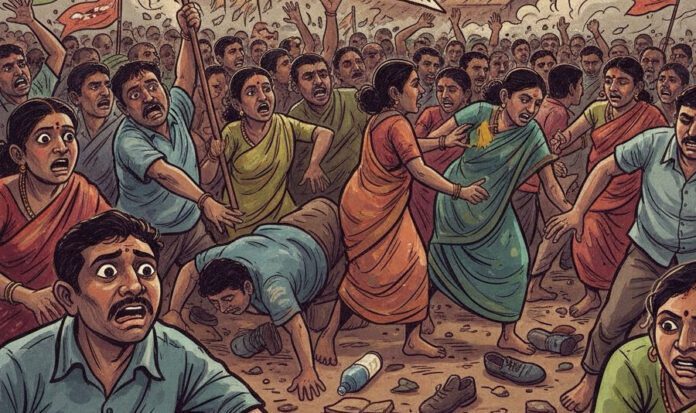On 27 September 2025, a political rally in Karur, Tamil Nadu turned into a nightmare. What began as a gathering of supporters of actor-turned-politician Vijay ended in chaos — at least 41 people lost their lives, dozens more were injured in a crowd crush.
This is not just another tragedy. It is a warning — about how mass events are organised, how political symbolism overrides public safety, and how states in the south must reexamine their approach to crowd management.
Let’s break this down.
The Anatomy of the Disaster
Delay. Overcrowding. Mismatch.
Vijay’s arrival at the venue was delayed by nearly 6–7 hours. Attendees had assembled under the sun for hours, many skipping meals, water, or shade.
The crowd swelled far beyond the capacity the police and organisers had estimated.
Poor venue design and missing buffer zones
The site’s layout, with bottlenecks near generator sheds and broadcast vans, turned pressure points into fatal choke zones. The lack of adequate safety corridors or exit routes made rescue efforts almost impossible.
Governance and political spectacle colliding
The delay was apparently by design — some allege to showcase “popularity” by drawing a larger crowd.
When political optics matter more than protocols, the balance is lost.
Why This Matters for South Matters?
- South India isn’t immune to mass event risks
Often, we think of overcrowding disasters as being from religious pilgrimages or northern festivals. But this tragedy at a political rally in Tamil Nadu reminds us that every public gathering — cultural, political, religious — carries risk when scaled.
- Political mobilisation must not override citizen safety
In southern states, politics is deeply emotive. Film stars, godmen, regional leaders draw powerful followings. But no rally — even for the most loved leader — justifies losing lives.
- Interstate spillovers: crowd culture & precedent
News of this tragedy will influence how states like Karnataka, Kerala, Andhra Pradesh plan their own rallies. Once a precedent is set — poor crowd control tolerated — the bar for accountability lowers everywhere.
- Systemic change needs to come from protocol + accountability
Rally permits must enforce safe capacity, not just symbolic numbers.
Buffer zones, multiple entry & exit paths, medical facilities, shade, water, crowd tracking tech — all must be non-negotiable.
Independent audits, penal action when protocols fail, and community oversight must accompany the glamor of electioneering.
What Needs to Change, Fast?
| Domain | What Must Happen |
| State & Police Policy | Mandate risk assessments, real-time crowd monitoring, emergency evacuation drills |
| Political Parties | Commit publicly to safety-first protocols, avoid organizing for spectacle over substance |
| Event Organisers | Invest in infrastructure (lighting, shade, medical, exit routes), train volunteers in crowd control |
| Citizens & Media | Demand transparency (attendance estimates, safety plans), question rallies where safety is compromised |
The Larger Question: What Kind of Democracy Do We Want?
In democratic politics, public rallies are essential — they fire up supporters, offer visibility, and show strength. But if democracy demands crowds, it also demands safety.
When a state allows political theatre to undermine human life, it endorses a dangerous message: popularity above protection.
This is the moment for South India to lead the way — to insist that political expression and public safety go hand in hand. Let Karur not become another statistic. Let it become the turning point.

